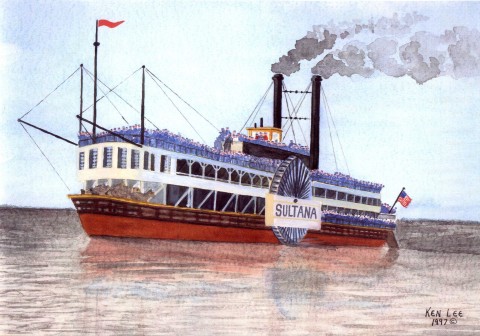


Original painting by Ken Lee
© 1997
Compiled & Edited
by
Linda Cunningham Fluharty© April, 2003
ISBN 0-9759097-0-3
Library of Congress Control Number 2004095340
Published by Linda Cunningham Fluharty
Baton Rouge, Louisiana
Printed in the United States of America
on acid-free paper
LIMITED EDITION!
Only 75 books published - OUT OF PRINT
E-mail: LCFlu@aol.com
Site Map: www.lindapages.com
This book was completed in April 2003, at which time it was offered FREE online. Additionally, 75 hardbound books were made. Many were given to West Virginia libraries and the remaining books were given to the Wheeling Area Genealogical Society to sell for a fundraiser.
INTRODUCTION
Initially, this book focused squarely on providing an accurate account of the nineteen, recently paroled, West Virginia Civil War soldiers, and one from Virginia, whose fate it was to be aboard the overloaded Sultana it suddenly exploded on the Mississippi River on April 27, 1865.
The inspiration for this project was found in letters included in the pension file of George C. Loy, a Sultana survivor and a soldier in Carlin’s Battery “D” of the First West Virginia Light Artillery regiment. He wrote a letter home, following his release from Andersonville, as he was waiting to be exchanged. A second letter was written the day following the explosion of the Sultana.
But as the research progressed, the facts broadened the scope of the story of the West Virginia soldiers on the Sultana.
Having essentially no knowledge of the organization at Camp Sumter - Andersonville prison - my perception was that all of the Union soldiers were starved and treated brutally. Knowing that 150 men died there each day, I imagined that all of those on the Sultana were very weak. I wondered how any had enough strength to fight for survival, especially those who were in the water for many hours following the explosion.
Then I found out about JAMES W. DUNCAN, a baker from Wheeling, West Virginia, who had gone to New Orleans, Louisiana and joined the 5th Louisiana Infantry in May 1861. This Confederate soldier was the benefactor of many of the West Virginia soldiers who were imprisoned at Andersonville. His compelling story is presented here, largely through court documents, because of his tremendous impact on the lives and health of the prisoners who were later on the Sultana.
The West Virginia soldiers who perished in the Sultana explosion may also have known Duncan as an advocate but their testimonies would never be heard.
A single Union soldier from Virginia is included here because his name does not appear in any book I have seen on the subject of the Sultana. His regiment, the Loudoun County (Virginia) Rangers, was closely aligned with the West Virginia troops.
To avoid speculation, documents and records are consistently presented to tell the story of each soldier.
In no way does this book attempt to detail the events and circumstances surrounding the Sultana disaster. That information was extensively and incomparably presented in, The Sultana Tragedy, by Jerry O. Potter, and more recently in, Disaster on the Mississippi, by Gene Eric Salecker. Both books are highly recommended for the factual account of the tragedy and for the abundance of information about soldiers from other states.




